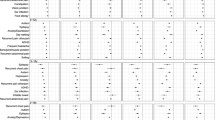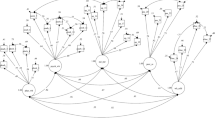Abstract
Purpose
Parents of children with chronic illnesses are at risk for poor health-related quality of life (HRQoL), with numerous identified risk factors, but the most informative statistical model considering their combined impact is unclear. The authors conceptualized risk for poor HRQoL using a summed model, comprehensive multivariate model, and latent profile analysis (LPA).
Methods
Community parents completed an online survey, providing information about demographics, child’s chronic illness, family functioning, and parent and child HRQoL. Parents reported that their children had a variety of chronic conditions (e.g., asthma, headaches, attention deficit/hyperactivity disorder, neurofibromatosis).
Results
The summed model did not account for a significant proportion of variance in parent HRQoL. The comprehensive multivariate model (R 2 = 0.614) and LPA (R 2 = 0.305) both significantly predicted parent HRQoL. The LPA identified two risk profiles for lower HRQoL: parents who reported milder illnesses, but poorer family functioning; and parents who reported greater disease severity, but better family functioning.
Conclusions
Comprehensive multivariate models or LPAs best conceptualize patterns of risk for poor parental HRQoL in the community; though the findings in the current community sample may not extend to parents recruited from specialty clinics whose children may have more severe chronic illnesses. Parents of children with mild chronic conditions are still at risk for poor HRQoL, warranting attention from health care providers.


Similar content being viewed by others
References
Halfon, N., & Newacheck, P. W. (2010). Evolving notions of childhood chronic illness. Journal of the American Medical Association, 303, 665–666.
Van Cleave, J., Gortmaker, S. L., & Perrin, J. M. (2010). Dynamics of obesity and chronic health conditions among children and youth. Journal of the American Medical Association, 303, 623–630.
Cousino, M. K., & Hazen, R. A. (2013). Parenting stress among caregivers of children with chronic illness: A systematic review. Journal of Pediatric Psychology, 38, 809–828.
Palermo, T. M., & Eccleston, C. (2009). Parents of children and adolescents with chronic pain. Pain, 146, 15–17.
Matza, L. S., Swensen, A. R., Flood, E. M., Secnik, K., & Leidy, N. K. (2006). Assessment of health-related quality of life in children: A review of conceptual, methodological, and regulatory issues. Value in Health: The Journal of the International Society for Pharmacoeconomics and Outcomes Research, 7, 79–92.
Haverman, L., van Oersm, H. A., Maurice-Stam, H., Kuijpers, T. W., Grootenhuis, M. A., & van Rossum, M.A.J. (2014). Health related quality of life and parental perceptions of child vulnerability among parents of children with juvenile idiopathic arthritis: Results from a web-based survey. Pediatric Rheumatology, 12, 34–44.
Hunfeld, J.A.M., Perquin, C. W., Duivenvoorden, H. J., Hazebroek-Kampschreur, A.A.J.M., Passchier, J., van Suijlekom-Smit, L.W.A, et al. (2001). Chronic pain and its impact on quality of life in adolescents and their families. Journal of Pediatric Psychology, 26, 145–153.
Kunz, J. H., Greenley, R. N., & Howard, M. (2011). Maternal, paternal, and family health-related quality of life in the context of pediatric inflammatory bowel disease. Quality of Life Research, 20, 1197–1204.
Medrano, G. R., Berlin, K. S., Davies, W. H. (2013). Utility of the PedsQL family impact module: Assessing the psychometric properties in a community sample. Quality of Life Research, 22, 2899–2907.
Drotar, D., & Bonner, M. S. (2009). Influences on adherence to pediatric asthma treatment: A review of correlates and predictors. Journal of Developmental and Behavioral Pediatrics, 30, 574–582.
Dobbels, F., Decorte, A., Roskams, A., & Van Damme-Lombaerts, R. (2010). Health-related quality of life, treatment adherence, symptom experience and depression in adolescent renal transplant patients. Pediatric Transplant, 14, 216–223.
Logan, D. E., & Scharff, L. (2005). Relationships between family and parent characteristics and functional abilities in children with recurrent pain syndromes: An investigation of moderating effects on the pathway from pain to disability. Journal of Pediatric Psychology, 30, 698–707.
De Civita, M., & Dobkin, P. L. (2003). Pediatric adherence as a multidimensional and dynamic construct, involving a triadic partnership. Journal of Pediatric Psychology, 29, 157–169.
Stein, R. E., & Jessop, D. J. (1982). A noncategorical approach to chronic childhood illness. Public Health Reports, 97, 354–362.
Wallander, J. L., & Varni, J. W. (1992). Adjustment in children with chronic physical disorders: Programmatic research on a disability-stress-coping model. In A. M. La Greca, L. J. Siegel, J. L. Wallander & C. E. Walker (Eds.), Stress and Coping in Child Health (pp. 279–298). New York: The Guilford Press.
Jones, D. J., Forehand, R., Brody, G., & Armistead, L. (2002). Psychosocial adjustment of African American children in single-mother families: A test of three risk models. Journal of Marriage and Family, 64, 105–115.
Gumidyala, A. P., & Greenley, R. N. (2014). Correlates of health-related quality of life in pediatric inflammatory bowel disease: A cumulative risk model approach. Journal of Pediatric Psychology, 39, 55–64.
Josie, K. L., Greenley, R. N., & Drotar, D. (2007). Cumulative risk and asthma outcomes in inner-city African-American youth. Journal of Asthma, 44, 5350541.
Greenley, R. N., & Cunningham, C. (2009). Parent quality of life in the context of pediatric inflammatory bowel disease. Journal of Pediatric Psychology, 34, 129–136.
Demirtepe-Sayguli, D., & Bozo, O. (2011). Perceived social support as a moderator of the relationships between caregiver well-being indicators and psychological symptoms. Journal of Health Psychology, 16, 1091–1100.
Gray, W. N., Graef, D. M., Schuman, S. S., Janicke, D. M., & Hommel, K. A. (2013). Parenting stress in pediatric IBD: Relations with child psychopathology, family functioning, and disease severity. Journal of Developmental Behavioral Pediatrics, 34, 237–244.
Moreira, H., Frontini, R., Bullinger, M., & Canavarro, M. C. (2013). Caring for a child with Type 1 diabetes: Links between family cohesion, perceived impact, and parental adjustment. Journal of Family Psychology, 27, 731–742.
Bergman, L. R., von Eye, A., & Magnusson, D. (2006). Person-oriented research strategies in developmental psychopathology. In D. Cicchetti & D. J. Cohen (Eds.), Developmental Psychopathology, Vol 1: Theory and method (2nd edn., pp. 850–888). Hoboken, NJ: Wiley.
Berlin, K. S., Parra, G. R., Williams, N. A. (2014). An introduction to latent variable mixture modeling (part 2): Longitudinal latent class growth analysis and growth mixture models. Journal of Pediatric Psychology, 39, 188–203.
Berlin, K. S., Williams, N. A., Parra, G. R. (2014). An introduction to latent variable mixture modeling (part 1): Overview and cross-sectional latent class and latent profile analyses. Journal of Pediatric Psychology, 39, 174–187.
Parra, G. R., DuBois, D. L., & Sher, K. J. (2006). Investigation of profiles of risk factors for adolescent psychopathology: A person-centered approach. Journal of Clinical Child and Adolescent Psychology, 35, 386–402.
Berlin, K. S., Karazsia, B. T., Klages, K. L. Research design in pediatric psychology: The state of our science, recommendations, and future considerations. In M. Roberts & R. Steele (Eds.) Handbook of pediatric psychology, 5th Edition. New York: Guilford Press. (in press).
Muthén, B. O. (2001). Latent variable mixture modeling. In G. A. Marcoulides & R. E. Schumacker (Eds.), New developments and techniques in structural equation modeling (pp. 1–33). Mahaw, NJ: Lawrence Erlbaum & Associates.
Varni, J. W., Sherman, S. A., Burwinkle, T. M., Dickinson, P. E., & Dixon, P. (2004). The PedsQL family impact module: Preliminary reliability and validity. Health and Quality of Life Outcomes, 2, 55.
Stein, R.E.K., Gortmaker, S. L., Perrin, E. C., Perrin, J. M., Pless, I. B., Walker, D. K., et al. (1987). Severity of illness: Concepts and measurements. Lancet, 26, 1506–1509.
Blake, R. L., & McKay, D. A. (1986). A single-item measure of social supports as a predictor of morbidity. Journal of Family Practice, 22, 82–84.
Varni, J. W., Seid, M., & Kurtin, P. S. (2001). PedsQL 4.0: Reliability and validity of the Pediatric Quality of Life inventory version 4.0 generic core scales in healthy and patient populations. Medical Care, 39, 800–812.
Hainsworth, K. R., Davies, W. H., Anderson Khan, K., & Weisman, S. J. (2007). Development and preliminary validation of the Child Activity Limitations Questionnaire: Flexible and efficient assessment of pain-related functional disability. Journal of Pain, 8, 746–752.
Schwarz, G. E. (1978). Estimating the dimension of a model. Annals of Statistics, 6(2), 461–464.
Akaike, H. (1987). Factor analysis and AIC. Psychometrika, 52, 317–332.
Kass, R. E., & Raftery, A. E. (1995). Bayes factors. Journal of the American Statistical Association, 90, 773–795.
Raftery, A. E. (1995). Bayesian model selection in social research. Sociological Methodology, 25, 111–163.
Asparouhov, T., & Muthen, B. (2014). Multiple-group factor analysis alignment. Structural Equation Modeling: A Multidisciplinary Journal. doi:10.1080/10705511.2014.919210.
Lo, Y., Mendell, N., & Rubin, D. (2001). Testing the number of components in a normal mixture. Biometrika, 88, 767–778.
McLachlan, G.J., Peel, D. (2000). Finite mixture modeling. New York, NY: Wiley.
Vermunt, J. K. (2010). Latent class modeling with covariates: Two improved three-step approaches. Political Analysis, 18, 450–469.
Eccleston, C., Palermo, T. M., Fisher, E., & Law, E. (2012). Psychological interventions for parents of children and adolescents with chronic illness (review). Cochrane Database of Systematic Reviews, 8, CD009660.
Borowsky, S. J., Rubenstein, L. V., Meredith, L. S., Camp, P., Jackson-Triche, M., & Wells, K. B. (2001). Who is at risk of nondetection of mental health problems in primary care? Journal of General Internal Medicine, 15, 381–388.
Everhart, R. S., Fiese, B. H., & Smyth, J. M. (2008). A cumulative risk model predicting caregiver quality of life in pediatric asthma. Journal of Pediatric Psychology, 33, 809–818.
Palermo, T. M., & Chambers, C. T. (2005). Parent and family factors in pediatric chronic pain and disability: An integrative approach. Pain, 119, 1–4.
Author information
Authors and Affiliations
Corresponding author
Ethics declarations
Conflict of interest
All authors declare that they have no conflicts of interest.
Ethical approval
All procedures performed in studies involving human participants were in accordance with the ethical standards of the institutional and/or national research committee and with the 1964 Helsinki declaration and its later amendments or comparable ethical standards.
Informed consent
Informed consent was obtained from all individual participants included in the study.
Rights and permissions
About this article
Cite this article
Defenderfer, E.K., Rybak, T.M., Davies, W.H. et al. Predicting parent health-related quality of life: evaluating conceptual models. Qual Life Res 26, 1405–1415 (2017). https://doi.org/10.1007/s11136-016-1491-3
Accepted:
Published:
Issue Date:
DOI: https://doi.org/10.1007/s11136-016-1491-3




